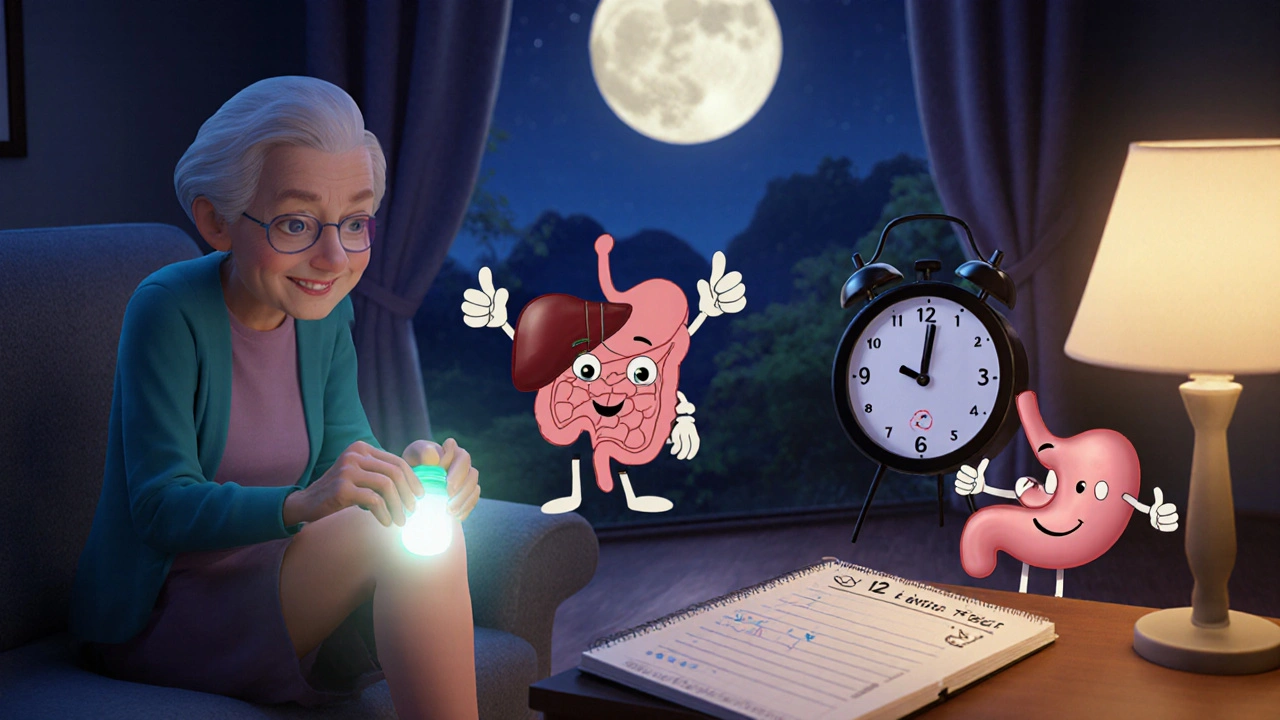Millions of people reach for Nurofen every day when a headache hits, muscles ache, or fever spikes. But do you know what’s actually in that little tablet? And more importantly-could something else work better for you?
Nurofen is just a brand name for ibuprofen, a common painkiller that’s been around since the 1960s. It’s part of a group called NSAIDs-nonsteroidal anti-inflammatory drugs. That means it doesn’t just numb pain; it tackles inflammation too. But it’s not the only option. There are cheaper, gentler, or stronger alternatives depending on what you’re treating and how your body reacts.
What’s in Nurofen, really?
Nurofen tablets contain 200 mg of ibuprofen per dose. That’s the standard over-the-counter strength in most countries. Higher doses (like 400 mg or 600 mg) are available by prescription. Ibuprofen works by blocking enzymes called COX-1 and COX-2, which produce chemicals that cause pain, swelling, and fever. It kicks in within 20 to 30 minutes and lasts about 4 to 6 hours.
But here’s the catch: ibuprofen can irritate your stomach lining. Long-term or high-dose use increases the risk of ulcers, internal bleeding, and kidney problems. People with heart conditions, high blood pressure, or a history of stomach issues are often told to avoid it. If you’ve ever felt queasy after taking Nurofen, you’re not alone.
Paracetamol (acetaminophen): The gentle alternative
If your main concern is pain or fever without inflammation, paracetamol (sold as Tylenol, Panadol, or Calpol) might be a better fit. It doesn’t reduce swelling like ibuprofen, but it’s much easier on your stomach. It’s the go-to for children, pregnant women, and people with sensitive stomachs.
Studies show paracetamol works just as well as ibuprofen for headaches, toothaches, and mild arthritis pain. A 2020 review in The BMJ found no clear advantage of ibuprofen over paracetamol for most common pains-except in cases of inflammation, like sprains or menstrual cramps.
The downside? Paracetamol doesn’t touch inflammation. And if you take too much-just 10 grams in one go-it can cause serious liver damage. Stick to the label: no more than 4,000 mg in 24 hours. That’s eight 500 mg tablets. Many cold and flu meds also contain paracetamol, so check ingredients to avoid accidental overdose.
Aspirin: Old school, but risky
Aspirin has been used since 1897. It’s also an NSAID, like ibuprofen, so it reduces pain, fever, and inflammation. But it’s not usually the first choice for everyday aches anymore.
Why? Because it thins your blood. That’s useful for preventing heart attacks in high-risk people-but dangerous if you’re prone to bleeding, have ulcers, or are scheduled for surgery. It’s also linked to Reye’s syndrome in children, so it’s off-limits under age 16.
Some people still use low-dose aspirin (75-100 mg daily) for heart protection. But if you’re not at high risk for cardiovascular disease, the risks outweigh the benefits. For simple pain relief, aspirin offers no real edge over ibuprofen or paracetamol-and it’s more likely to upset your stomach.
Naproxen: Stronger, longer-lasting
Naproxen (sold as Aleve or Naprosyn) is another NSAID, but it lasts longer than ibuprofen. A single 220 mg dose can provide up to 12 hours of relief. That’s why some people with chronic pain-like osteoarthritis or lower back pain-prefer it.
One 2022 study in The Lancet found naproxen to be slightly more effective than ibuprofen for joint pain, especially when taken twice daily. It also has a lower risk of heart attack compared to other NSAIDs, according to the FDA.
But it’s not safer overall. Naproxen still carries stomach and kidney risks. And because it lasts longer, you’re less likely to notice if you’ve taken too much. Overdose symptoms can sneak up slowly: nausea, dizziness, ringing in the ears, or even confusion.

Topical options: Creams, gels, patches
If you’re worried about swallowing pills or have pain in one spot-like a sore knee or stiff shoulder-topical NSAIDs might be the answer. Products like Voltaren Gel (diclofenac) or Ibuprofen Gel deliver the drug directly to the skin.
Studies show topical NSAIDs are as effective as oral ones for localized pain, with far fewer side effects. Since the drug doesn’t enter your bloodstream in large amounts, your stomach and kidneys are spared. The downside? You need to apply it multiple times a day, and it won’t help with full-body pain like a fever or headache.
Some people also swear by menthol or capsaicin creams. They don’t reduce inflammation, but they distract nerves from sending pain signals. They’re safe for long-term use and work well alongside oral meds.
When to avoid all NSAIDs
Not everyone can take ibuprofen-or any NSAID. You should skip them if you:
- Have had a stomach ulcer or gastrointestinal bleeding
- Have severe kidney disease
- Are in the third trimester of pregnancy
- Have uncontrolled high blood pressure or heart failure
- Take blood thinners like warfarin or aspirin for heart protection
If you’re on any of these medications, paracetamol is usually the safest painkiller. But always check with your doctor or pharmacist before switching.
What about natural remedies?
Turmeric, ginger, and omega-3s have anti-inflammatory properties. Some small studies suggest they help with joint pain, especially in arthritis. But they’re not fast-acting. You won’t feel relief in 30 minutes like you do with Nurofen.
They also aren’t regulated like medicines. A turmeric supplement might contain anything from zero to 10 times the labeled dose of curcumin. And some can interact with blood thinners or diabetes meds. Don’t replace prescribed pain relief with herbs without talking to your doctor.

Which one should you choose?
Here’s a simple guide based on your needs:
| Need | Best Option | Why |
|---|---|---|
| Headache, fever, mild pain | Paracetamol | Safe, gentle, no stomach upset |
| Swelling, sprain, menstrual cramps | Ibuprofen (Nurofen) | Reduces inflammation, fast relief |
| Chronic joint pain, longer relief needed | Naproxen | Longer-lasting, slightly stronger |
| Localized pain (knee, back) | Topical NSAID gel | Targeted, minimal side effects |
| Stomach sensitive, elderly, pregnant | Paracetamol | Lowest risk profile |
There’s no universal winner. Your best painkiller depends on your body, your condition, and your history. If one doesn’t work, try another. But never stack them. Don’t take ibuprofen and naproxen together. Don’t mix paracetamol with cold meds that already contain it.
When to call a doctor
Most pain is temporary. But if you’re relying on painkillers for more than 10 days straight-or if you need more than the maximum daily dose-it’s time to find out why. Persistent pain could signal something deeper: arthritis, nerve damage, infection, or even a hidden condition.
Also, if you notice any of these symptoms after taking painkillers:
- Black, tarry stools or vomiting blood
- Sudden swelling in your legs or ankles
- Difficulty breathing or chest pain
- Yellowing of skin or eyes
- Rash, blisters, or peeling skin
Stop taking the medication and get medical help right away. These could be signs of serious reactions.
Is Nurofen stronger than paracetamol?
It depends on the pain. Nurofen (ibuprofen) works better for inflammation-related pain like swollen joints, sprains, or period cramps. Paracetamol is just as effective for headaches, fevers, or general aches without swelling. Neither is universally stronger-they just work differently.
Can I take Nurofen and paracetamol together?
Yes, it’s safe to take ibuprofen and paracetamol together if you need stronger relief. Many doctors recommend this combo for moderate to severe pain, like after surgery or a bad injury. Just stick to the recommended doses for each and don’t exceed the daily limit for either.
Is Nurofen better than aspirin for headaches?
For most people, yes. Nurofen (ibuprofen) is faster acting and gentler on the stomach than aspirin. Aspirin carries higher bleeding risks and isn’t safe for children. Unless you’re taking low-dose aspirin for heart protection, ibuprofen is the smarter choice for headaches.
What’s the safest painkiller for long-term use?
There’s no perfect long-term painkiller. But paracetamol has the lowest risk profile for most people when used correctly. Topical NSAIDs are also safer for chronic joint pain. Avoid daily NSAIDs like ibuprofen or naproxen for more than a few weeks without medical supervision.
Does Nurofen make you sleepy?
No, standard Nurofen (ibuprofen) doesn’t cause drowsiness. But some combination products (like Nurofen Plus) include codeine, which can make you sleepy. Always check the label. If you feel drowsy after taking plain Nurofen, it could be due to your illness, not the medicine.
Final thought: Know your body
Painkillers aren’t one-size-fits-all. What works for your friend might give you an upset stomach or do nothing at all. The key is matching the drug to your pain type, your health, and your history. Keep a simple log: what you took, when, and how it worked. That way, you’ll know what to reach for next time-and what to avoid.
And if you’re still unsure? Talk to your pharmacist. They’re trained to help you choose the right pain relief-without a prescription.


8 Comments
Alyssa Fisher
It's fascinating how we've normalized popping pills like candy without ever asking why our bodies are screaming in the first place. Ibuprofen doesn't cure inflammation-it just muffles the alarm. But what if the alarm exists because we're sitting too much, eating too much processed junk, or sleeping like zombies? We treat symptoms like enemies instead of messengers.
Paracetamol’s gentler, sure-but it’s also a bandaid on a broken leg. We need to stop outsourcing our health to pharmacies and start listening to what our bodies are trying to tell us. Not every ache needs a chemical solution. Sometimes it just needs rest, movement, or a damn good nap.
William Priest
lol so Nurofen is just ibuprofen?? Wow i had no idea 😂
like i thought it was some super advanced german science or something. my bad. i guess i’ve been drinking the pharma kool-aid.
also why is everyone so scared of aspirin? it’s literally the OG painkiller. we used to give it to kids before they realized it could turn them into glowing ghosts. 🧟♂️
Jim Oliver
You people are overthinking this. Paracetamol is for wimps. If you can’t handle ibuprofen’s side effects, you shouldn’t be alive. Also, naproxen is the only real option. Everything else is just placebo with a fancy label. And topical gels? Cute. You’re not a 70-year-old with arthritis. You’re 28 and you hurt your back lifting a bag of rice. Take the pill. Stop being a baby.
Also, turmeric? That’s not medicine. That’s what you sprinkle on your eggs because you watched a YouTube video. Grow up.
Jay Wallace
Wow. So much info. I didn’t realize Nurofen was just ibuprofen… I thought it was like… a proprietary blend? Some kind of elite pain-tech? Like, is this like… comparing Coca-Cola to generic cola??
Also, why is everyone so obsessed with paracetamol? It’s literally just acetaminophen. We’ve been calling it that since the 80s. Why do you guys act like it’s some new-age miracle? It’s not. It’s just… chemical. Like everything else.
And naproxen? That’s what my grandpa took. He died at 89. He also ate bacon for breakfast every day. So… I don’t know. I just take what’s on sale.
Also, topical gels? I tried one. It made my skin itch. So I stopped. And then I took two ibuprofen. Problem solved. End of story.
Beth Banham
I’ve been using topical diclofenac for my knee for two years now. No stomach issues, no liver stress. Just a little greasy residue on my jeans. It’s not glamorous, but it works. I don’t take anything else unless I’m traveling and forget my gel. Then I grab paracetamol. Simple. Safe. Doesn’t cost a fortune.
Also, I don’t think anyone here is overthinking it. We’re just trying to be smart about what we put in our bodies. That’s not weakness. It’s responsibility.
Ryan Masuga
Y’all are doing great just by asking these questions. Seriously. Most people just grab whatever’s in the cabinet and hope for the best. You’re thinking. That’s huge.
And yeah, ibuprofen isn’t evil-it’s just not magic. I used to take it for everything. Then I got a stomach ulcer. Now I use naproxen every other day + topical gel. And I drink ginger tea. It’s not perfect, but it’s mine.
Also, if you’re taking more than 10 days straight? Talk to your pharmacist. They’re basically painkillers whisperers. They won’t judge. They’ve seen it all.
Alyssa Salazar
Let’s get technical for a sec: COX-1 inhibition = GI toxicity. COX-2 selectivity = cardiovascular risk. Ibuprofen is a non-selective NSAID with a short half-life, so it’s more likely to cause acute GI events. Naproxen? Longer half-life, lower CV risk per FDA meta-analysis, but still a COX-1 offender. Topical NSAIDs? Localized pharmacokinetics reduce systemic exposure-Cmax drops 90% compared to oral. Paracetamol? Central COX inhibition, minimal peripheral action, hence no anti-inflammatory effect but safer for hepatic and GI profiles.
But here’s the kicker: none of this matters if you’re not tracking your intake. Polypharmacy is the silent killer. Check your OTC meds. That cold tablet? Probably has acetaminophen. You’re already at 3g before breakfast. Boom. Liver toxicity threshold crossed. You didn’t even know.
Brierly Davis
Love this thread. So much good info. I’m gonna start keeping a little pain journal like the post said. What I took, how I felt, how long it lasted. Maybe I’ll finally figure out why ibuprofen makes me dizzy but paracetamol doesn’t.
Also, big shoutout to the person who mentioned topical gels-I tried one last winter and it saved my shoulder. No more swallowing pills just for a sore joint. And no stomach drama. Win-win.
And hey, if you’re unsure? Talk to your pharmacist. They’re the real MVPs. 🙌